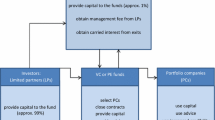Abstract
Using a tri-variate vector autoregression model, we study the relationships between the four Asian emerging equity markets: Hong Kong, Korea, Singapore and Taiwan, and the two largest equity markets in the world: U.S. and Japan. We find that while most of the unexpected variations in stock returns in these Asian emerging markets is explained by domestic own shocks, the impacts from the U.S. and Japan are larger in Hong Kong and Singapore than in Korea and Taiwan. This foreign effect is pronounced after the Crash of the October 1987, especially in Singapore.
Similar content being viewed by others
References
Bae, H.K. and Cheung, Y.L. (1998), International spillovers and volatility asymmetries: Evidence on the Hong Kong equity market, Asia Pacific J. Finance 1, 27-44.
Cheung, Y.L. (1993), A note on the stability of the intertemporal relationships between the Asian-Pacific equity markets and the developed markets: A non-parametric approach, J. Busin. Finance Account. 19, 229-236.
Cheung, Y.L. (1994), The impact of the Japanese market on the intraday Hong Kong stock returns, Financ. Engng. and the Japanese Markets 1, 129-135.
Cheung, Y.L. and Ho, Y.K. (1991), The intertemporal stability of the relationships between the Asian emerging equity markets and the developed markets, J. Busin. Finance Account. 18(January), 235-254.
Cheung, Y.L. and Mak, S.C. (1992), The international transmission of stock market fluctuation between the developed markets and the Asian-Pacific markets, Appl. Financ. Econom. 2, 43-47.
Dickey, D.A. and Fuller, W.A. (1979), Distribution of the estimations for autoregression time series with a unit root, J. Amer. Stat. Assoc. 74, 427-438.
Dickey, D.A. and Fuller, W.A. (1981), Likelihood ratio statistics of autoregressive time series with a unit root, Econometrica 49(July), 1057-1072.
Doan, T.A. (1990), User's Manual: RATS, Version 3.10, VAR Econometrics, Inc., Evanston.
Errunza, V.R. (1997), Gains from portfolio error of a coefficient of correlation into less-developed country's securities, J. Int. Busin. Stud. 8(Fall), 83-89.
Errunza, V.R. (1983), Emerging markets: A new opportunity for improving global portfolio performance, Financ. Analyst Journal 39(September/October), 51-58.
Eun, C.S. and Shim, S. (1989), International transmission of stock market movements, J. Financ. Quantitat. Anal. 24(June), 241-256.
Granger, C.W.J. and Morgenstern, O. (1970), Predictability of Stock Market Prices, Health-Lexington, Massachusetts.
Grubel, H. (1968), Internationally diversified portfolio: Welfare gains and capital flows, Amer. Econom. Rev. 58(December), 1299-1314.
Grubel, H. and Fadner, K. (1971), The interdependence of international equity markets, J. Finance 26(March), 89-94.
Hamao, Y., Masulis, R., and Ng, V. (1990), Correlation in price changes and volatility across international stock markets, Rev. Financ. Stud. 3, 281-307.
Ho, Y.K. (1990), Stock return seasonalities in Asia Pacific markets, J. Int. Financ. Managt. Account. 2, 47-78.
Hung, W.S. and Cheung, Y.L. (1995), Interdependence of Asian emerging equity markets, J. Busin. Finance Account. 22, 281-288.
Lin, W., Engle, R., and Ito, T. (1991), Do bull and bears move across borders? International transmission of stock return and volatility as the world turn, Working Paper, University of Wisconsin at Madison.
Joy, O.M., Panton, D.B., Reilly, F.K., Stanley, A.M. (1976), Comovements of major international equity markets, Financ. Rev. 11(March), 1-20.
Lessard, D. (1973), International portfolio diversification: A multivariate analysis for a group of Latin American countries, J. Finance 28(June), 619-633.
Levy, H. and Sarnat, M. (1970), International diversification of investment portfolios, Amer. Econom. Rev. 60(September), 668-675.
Makridakis, S.G. and Wheelwright, S.C. (1974), An analysis of the interrelationships among the major world stock exchanges, J. Busin. Finance Account. 1(2), 195-215.
Maldonado, R. and Saunders, A. (1981), International portfolio diversification and the intertemporal stability of international stock market relationships, 1957-78, Financ. Managt. 10(Autumn), 54-63.
Malliaris, A.G. and Urrutia, J.L. (1992), The international crash of October 1987: Causality tests, J. Financ. Quantitat. Anal. 27, 353-364.
Ng, V., Chang, R., and Chou, R. (1990), An examination of the behavior of international stock market volatility, Pacific-Basin Capital Market Research, Vol. II.
Panton, D.B., Lessiq, V.P., and Joy, O.M. (1976), Comovement of international equity markets: A taxonomic approach, J. Financ. Quantitat. Anal. 11(September), 415-431.
Philippatos, G.C., Christofi, A., and Christofi, P. (1983), The intertemporal stability of international stock market relationships: Another view, Financ. Managt. 12(Winter), 63-69.
Ripley, D.M. (1973), Elements in the linkage of national stock market indices, Rev. Econom. Statist. 55(August), 356-361.
Sims, C.A. (1980), Macroeconomics and reality, Econometrica 48(January), 1-48.
Sims, C.A. (1982), Policy analysis with econometric models, Brookings Papers on Economic Activity 1, 107-152.
Solnik, B.H. (1974), Why not diversify internationally rather than domestically? Financ. Anal. J. 30(July/August), 48-54.
Author information
Authors and Affiliations
Rights and permissions
About this article
Cite this article
Cha, B., Cheung, Yl. The Impact of the U.S. and the Japanese Equity Markets on the Emerging Asia-Pacific Equity Markets. Asia-Pacific Financial Markets 5, 191–209 (1998). https://doi.org/10.1023/A:1010038229774
Issue Date:
DOI: https://doi.org/10.1023/A:1010038229774




